Evaporation of Water/Alumina Nanofluid Film by Mixed Convection Inside Heated Vertical Channel
Abstract
1. Introduction
2. Analysis
- The nano film enters the channel with a temperature Tnf0, a thickness δ0 and a velocity unf0. The air enters with a temperature T0, mass fraction vapor c0 and a velocity u0. Assumptions are used to build up the mathematical system of the problem.
- The flows through the vertical channel are laminar and stationary (gas and film). The study of the transfers is in two-dimensional case.
- The nano film is considered as a boundary layer.
- Humid air is considered as an ideal mixture and perfect gas.
- We don’t take into the account the surface tension.
- The gas–nano fluid interface is in the thermodynamic equilibrium.
- We neglect the Soret and Duffour effects.
- In the energy equation, we don’t consider the pressure work terms, Radiation heat transfer and the viscous dissipation.
2.1. General Equations
2.1.1. For Liquid Phase
2.1.2. For Gas Phase
2.2. Boundary Conditions
2.3. Thermophysical properties
- λnf = λ water(1.72xv + 1)
- µnf = µ water(123xv2 + 7.3xv + 1)
- ρnf = (1 − xv) ρwater + xvρn
- (ρCp)nf = (1 − xv)(ρCp)water + xv(ρCp)n
- (ρβ)nf = (1 − xv)(ρβ)water + xv(ρβ)n
- (ρβ*)nf = (1 − xv)(ρβ*)water + xv(ρβ*)n
2.4. Validation and Mesh Stability
3. Results and Discussions
4. Conclusions
- The effect of the thermal conduction is significant and dominates the effect of density and the specific heat.
- An augmentation of the thermal conductivity induces an increase of the film temperature and the interfacial temperature, and consequently the vapor temperature.
- Augmentation of k exists because of the increase of xv.
- The saturation vapor concentration is elevated when we elevate the nanoparticle volume rate.
- Augmentation of k naturally increases the evaporation rate.
- The augmentation of the film density, due to the increase of xv, induces a deceleration of the film.
Author Contributions
Funding
Conflicts of Interest
List of Symbols
| u | axial velocity [m/s] |
| v | v transversal velocity [m/s] |
| p | p pressure [Pa] |
| x | axial coordinate [m] |
| y | transversal coordinate [m] |
| X | axial dimensionless coordinate |
| Y | transversal dimensionless coordinate |
| T | temperature [°K] |
| g | gravitational acceleration [m/s2] |
| h | heat transfer coefficient at the dry plate [J/m2·K] |
| c | mass fraction vapor |
| D | diffusivity [m2/s] |
| mnf0 | inlet mass flow rate [kg/m.s] |
| mt(X) | total evaporation rate [kg/s] |
| Nynf | knot number in y direction for liquid |
| Ny | knot number in y direction for gas |
| Lv | latent heat per mass unit |
| d | channel width [m] |
| H | channel length [m] |
| xv | Nano particle volume rate [ppm] |
| Greek symbols | |
| ρ | density [kg/m3] |
| μ | dynamic viscosity [kg/ms] |
| λ | thermal conductivity [W/mK] |
| δ | film thickness [m] |
| β | thermal expansion coefficient [K−1] |
| β* | mass expansion coefficient |
Subscripts
| 0 | inlet condition |
| i | interface |
| nf | nano fluid |
References
- Plawsky, J.L.; Ojha, M.; Chatterjee, A.; Wayner, P.C., Jr. Review of the effects of surface topography, surface chemistry, and fluid physics on evaporation at the contact line. Chem. Eng. Commun. 2009, 196, 658–696. [Google Scholar] [CrossRef]
- Wang, B.X.; Garimella, S.V.; Murthy, J.Y. An analytical solution for the total heat transfer in the thin-film region of an evaporating meniscus. Int. J. Heat Mass Transf. 2008, 51, 6317–6322. [Google Scholar] [CrossRef]
- Do, K.H.; Jang, S.P. Effect of nanofluids on the thermal performance of a flat micro heat pipe with a rectangular grooved wick. Int. J. Heat Mass Transf. 2010, 53, 2183–2192. [Google Scholar] [CrossRef]
- Zhao, J.-J.; Duan, Y.-Y.; Wang, X.-D.; Wang, B.-X. Effect of nanofluids on thin film evaporation in microchannels. J. Nanopart. Res. 2011, 13, 5033–5047. [Google Scholar] [CrossRef]
- Choi, S. Enhancing thermal conductivity of fluids with nanoparticles. Asme Fed. 1995, 231, 100–103. [Google Scholar]
- Lee, S.; Choi, S.S.; Li, S.; Eastman, J.A. Measuring thermal conductivity of fluids containing oxide nanoparticles. J. Heat Transf. 1999, 121, 280–289. [Google Scholar] [CrossRef]
- Xuan, Y.; Li, Q. Heat transfer enhancement of nanofluids. Int. J. Heat Fluid Flow 2000, 21, 58–64. [Google Scholar] [CrossRef]
- Xuan, Y.; Roetzel, W. Conceptions for heat transfer correlation of nanofluids. Int. J. Heat Mass Transf. 2000, 43, 3701–3707. [Google Scholar] [CrossRef]
- Ali, A.; Vafai, K.; Khaled, A.R. Analysis of heat and mass transfer between air and falling film in a cross flow configuration. Int. J. Heat Mass Transf. 2004, 47, 743–755. [Google Scholar] [CrossRef]
- Pak, B.C.; Cho, Y.I. Hydrodynamic and heat transfer study of dispersed fluids with submicron metallic oxide particles. Exp. Heat Transf. 1998, 11, 151–170. [Google Scholar] [CrossRef]
- Li, Q.; Xuan, Y. Convective heat transfer performances of fluids with nanoparticles. In Proceedings of the 12th International Heat Transfer Conference, Grenoble, France, 18–23 August 2002; pp. 483–488. [Google Scholar]
- Wen, D.; Ding, Y. Experimental investigation into convective heat transfer of nanofluids at the entrance region under laminar flow conditions. Int. J. Heat Mass Transf. 2004, 47, 5181–5188. [Google Scholar] [CrossRef]
- Yang, Y.; Zhang, Z.G.; Grulke, E.A.; Anderson, W.B.; Wu, G. Heat transfer properties of nanoparticle-in-fluid dispersions (nanofluids) in laminar flow. Int. J. Heat Mass Transf. 2005, 48, 1107–1116. [Google Scholar] [CrossRef]
- Fohanno, S.; Polidori, G.; Popa, C. Nanofluides et transfert de chaleur par convection naturelle; Journée Thématique SFT: Paris, France, 15 March 2012. [Google Scholar]
- Cherif, A.A.; Daif, A. Etude numérique du transfert de chaleur et de masse entre deux plaques planes verticales en présence d’un film de liquide binaire ruisselant sur l’une des plaques chauffée. Int. J. Heat Mass Transf. 1999, 42, 2399–2418. [Google Scholar] [CrossRef]
- Vachon, M. Etude De L’évaporation En Convection Naturelle. Ph.D. Thesis, Université De Poitiers, Grand Poitiers, France, 1979. [Google Scholar]
- Yan, W.M. Effects of film evaporation on laminar mixed heat ad mass tansfer in a vertical channel. Int. J. Heat Mass Transfer 1992, 35, 3419–3429. [Google Scholar]
- Mintsa, H.A.; Roy, G.; Nguyen, C.T.; Doucet, D. New temperature dependent thermal conductivity data for water-based nanofluids. Int. J. Therm. Sci. 2009, 48, 363–371. [Google Scholar] [CrossRef]
- Agunaoun, A.; Daif, A.; Baniol, R.; Dagunet, M. Evaporation en convection forcée d’un film mince s’écoulant en régime permanent, laminaire et sans ondes, sur une surface plane inclinée. Int. J. Heat Md Mass Transf. 1994, 37, 2947–2956. [Google Scholar] [CrossRef]
- Chen, R.H.; Phuoc, T.X.; Martello, D. Surface tension of evaporating nanofluid droplets. Int. J. Heat Mass Transf. 2011, 54, 2459–2466. [Google Scholar] [CrossRef]
- Orejon, D.; Sefiane, K.; Shanahan, M.E.R. Evaporation of nanofluid droplets with applied DC potential. J. Colloid Interface Sci. 2013, 407, 29–38. [Google Scholar] [CrossRef]
- Ni, G.; Miljkovic, N.; Ghasemi, H.; Huang, X.; Boriskina, S.V.; Lin, C.; Wang, J.; Xu, Y.; Rahman, M.M.; Zhang, T.J.; et al. Volumetric solar heating of nanofluids for direct vapor generation. Nano Energy 2015, 17, 290–301. [Google Scholar] [CrossRef]
- Amjad, M.; Raza, G.; Xin, Y.; Pervaiz, S.; Xu, J.; Du, X.; Wen, D. Volumetric solar heating and steam generation via gold nanofluids. Appl. Energy 2017, 206, 393–400. [Google Scholar] [CrossRef]
- Zhou, Y.; Li, Q.; Wang, Q. Energy Storage Analysis of UIO-66 and Water Mixed Nanofluids: An Experimental and Theoretical Study. Energies 2019, 12, 2521. [Google Scholar] [CrossRef]
- Moshizi, S.A. Forced convection heat and mass transfer of MHD nanofluid flow inside a porous microchannel with chemical reaction on the walls. Eng. Comput. 2015, 32, 2419–2442. [Google Scholar] [CrossRef]
- Moshizi, S.A.; Malvandi, A.; Ganji, D.D.; Pop, I. A two-phase theoretical study of Al2O3-water nanofluid flow inside a concentric pipe with heat generation/absorption. Int. J. Therm. Sci. 2014, 84, 347–357. [Google Scholar] [CrossRef]
- Moshizi, S.A. Conjugated effect of joule heating and magnetohydrodynamic on laminar convective heat transfer of nanofluid inside annulus pipe in the presence of slip condition. Int. J. Thermophys. 2016, 37, 1–22. [Google Scholar] [CrossRef]
- Moshizi, S.A.; Malvandi, A. Magnetic field Effects on nanoparticle migration at mixed convection of nanofluids in microchannels with temperature-dependent thermophysical properties. J. Taiwan Inst. Chem. Eng. 2016, 66, 269–282. [Google Scholar] [CrossRef]
- Moshizi, S.A.; Malvandi, A. Different modes of nanoparticle migration at mixed convection of Al2O3–water nanofluid inside a vertical microannulus in the presence of heat generation/absorption. J. Therm. Anal. Calorim. 2016, 126, 1947–1962. [Google Scholar] [CrossRef]
- Moshizi, S.A.; Zamani, M.; Hosseini, S.J.; Malvandi, A. Mixed convection of magnetohydrodynamic nanofluids inside microtubes at constant wall temperature. J. Magn. Magn. Mater. 2017, 430, 36–46. [Google Scholar] [CrossRef]
- Malvandi, A.; Moshizi, S.A.; Ganji, D.D. Nanoparticle transport effect on magnetohydrodynamic mixed convection of electrically conductive nanofluids in micro-annuli with temperature-dependent thermophysical properties. Phys. E Low Dimens. Syst. Nanostruct. 2017, 88, 35–49. [Google Scholar] [CrossRef]
- Sohail1, M.; Naz, R.; Abdelsalam, S. On the onset of entropy generation for a nanofluid with thermal radiation and gyrotactic microorganisms through 3D flows. Phys. Scr. 2020, 95, 4. [Google Scholar] [CrossRef]
- Eldesoky, I.M.; Abdelsalam, S.I.; El-Askary, W.A.; Ahmed, M.M. Concurrent development of thermal energy with magnetic field on a particle-fluid suspension through a porous conduit. BioNanoScience 2019, 9, 186–202. [Google Scholar] [CrossRef]
- Abdelsalam, S.I.; Bhatti, M.M. The study of non-Newtonian nanofluid with hall and ion slip effects on peristaltically induced motion in a non-uniform channel. Rsc Adv. 2018, 8, 7904–7915. [Google Scholar] [CrossRef]
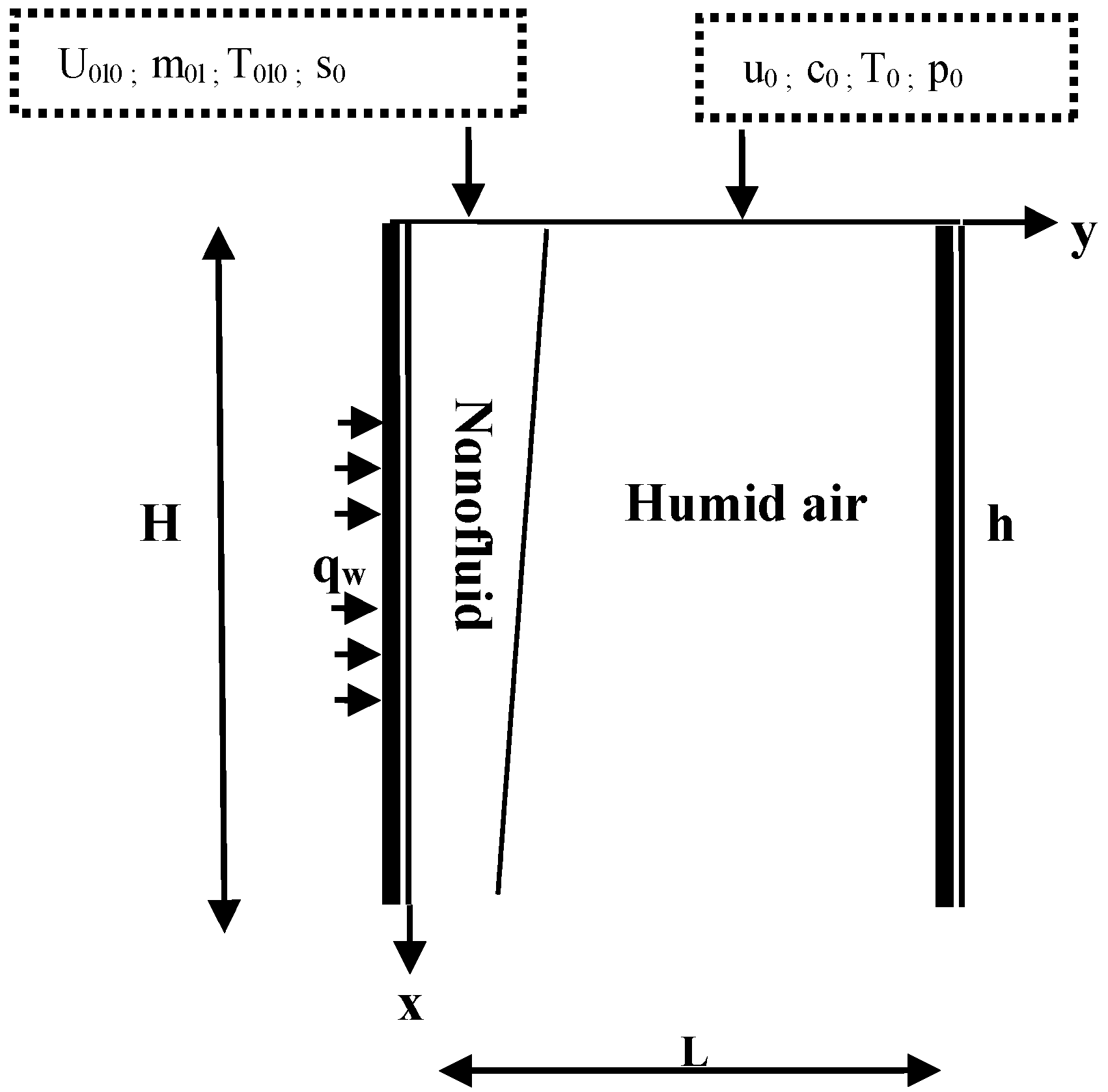
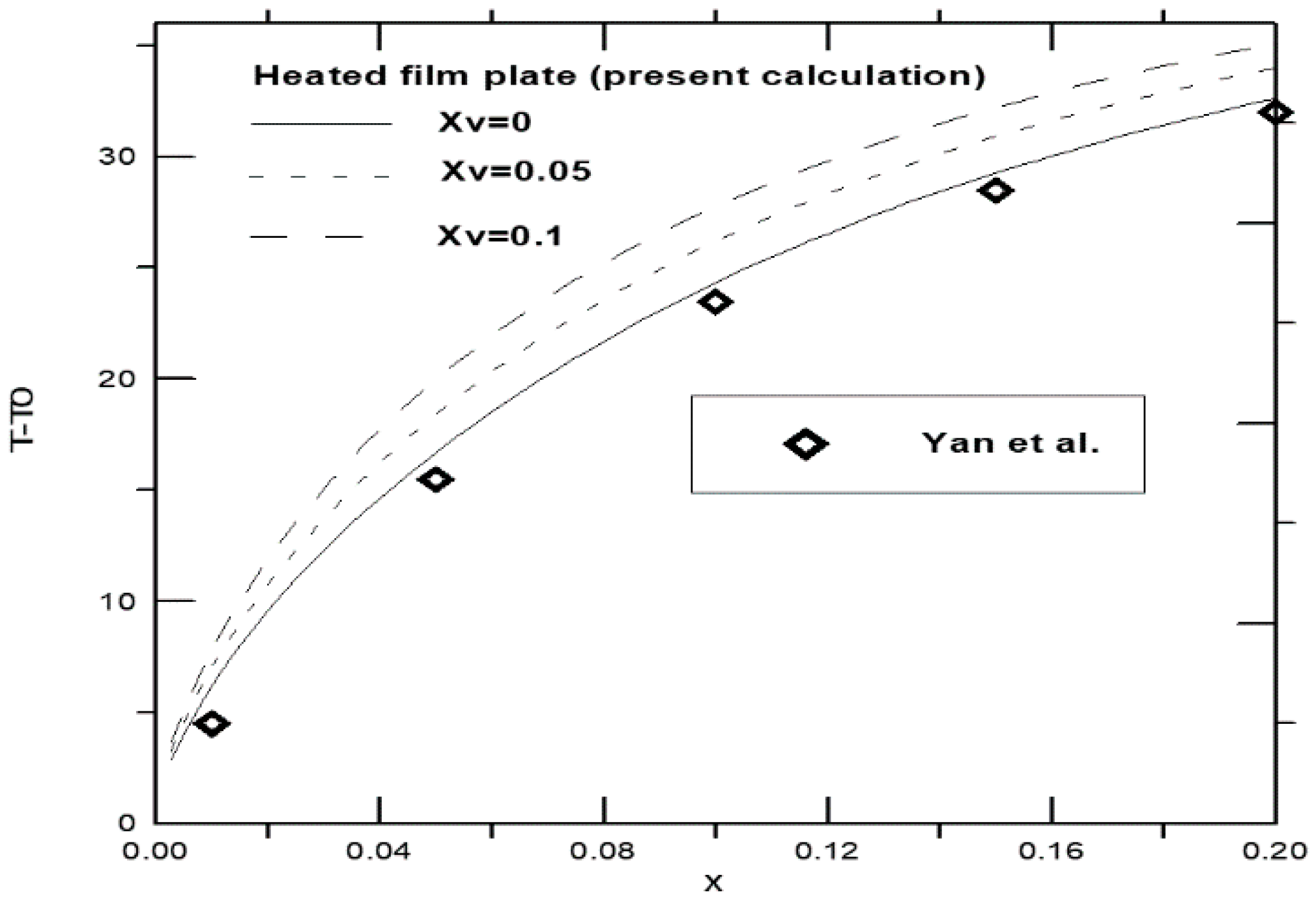
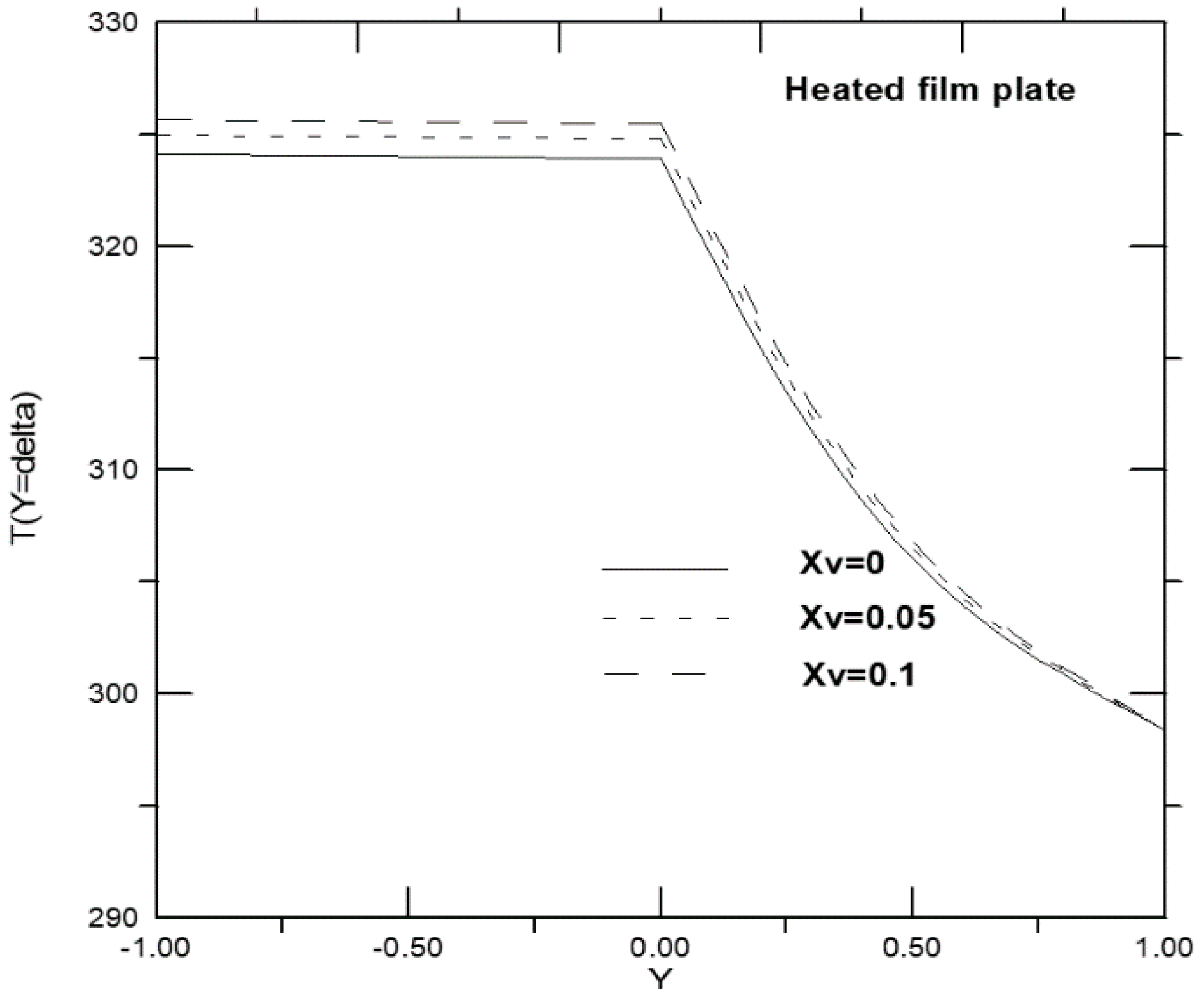
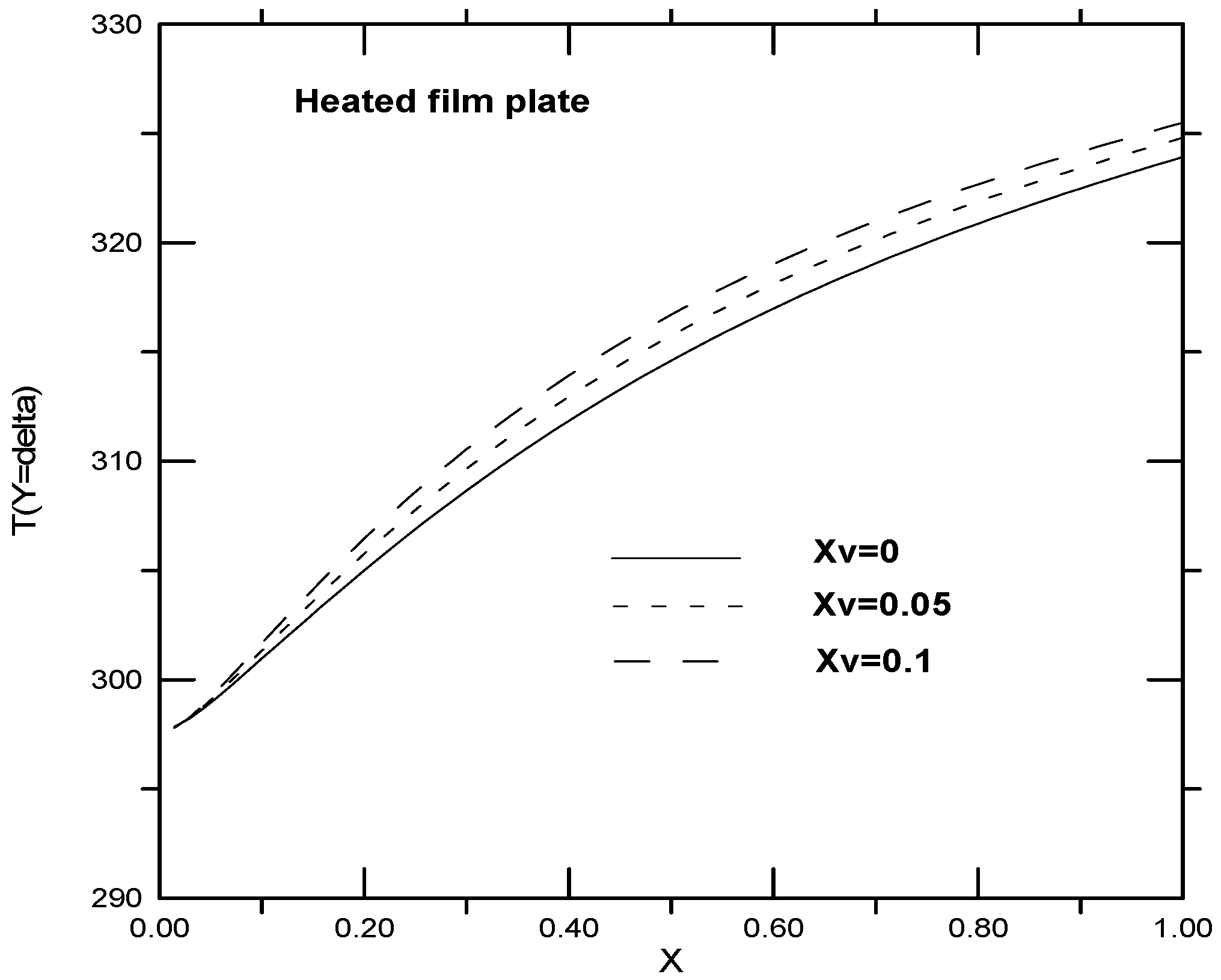
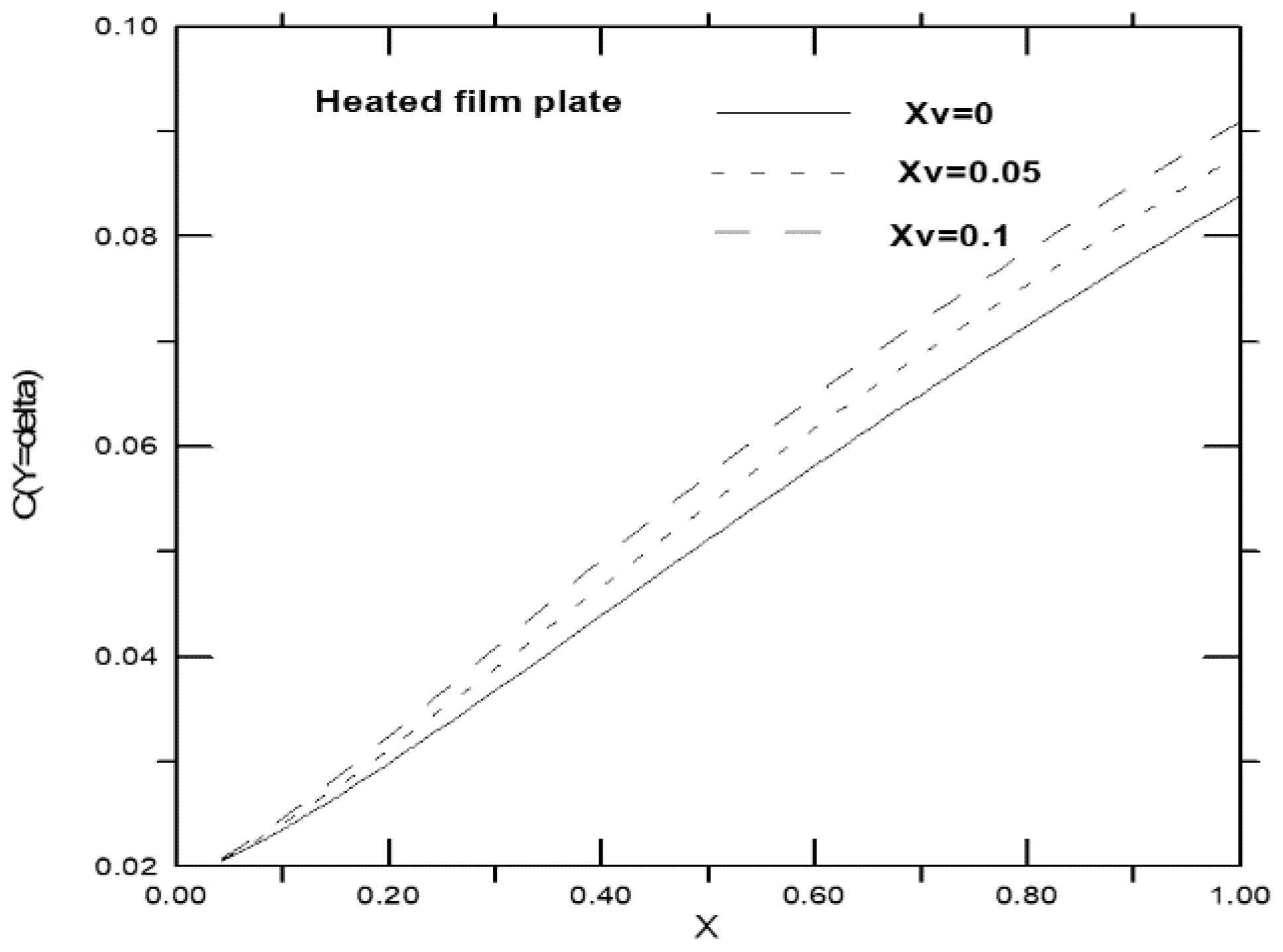
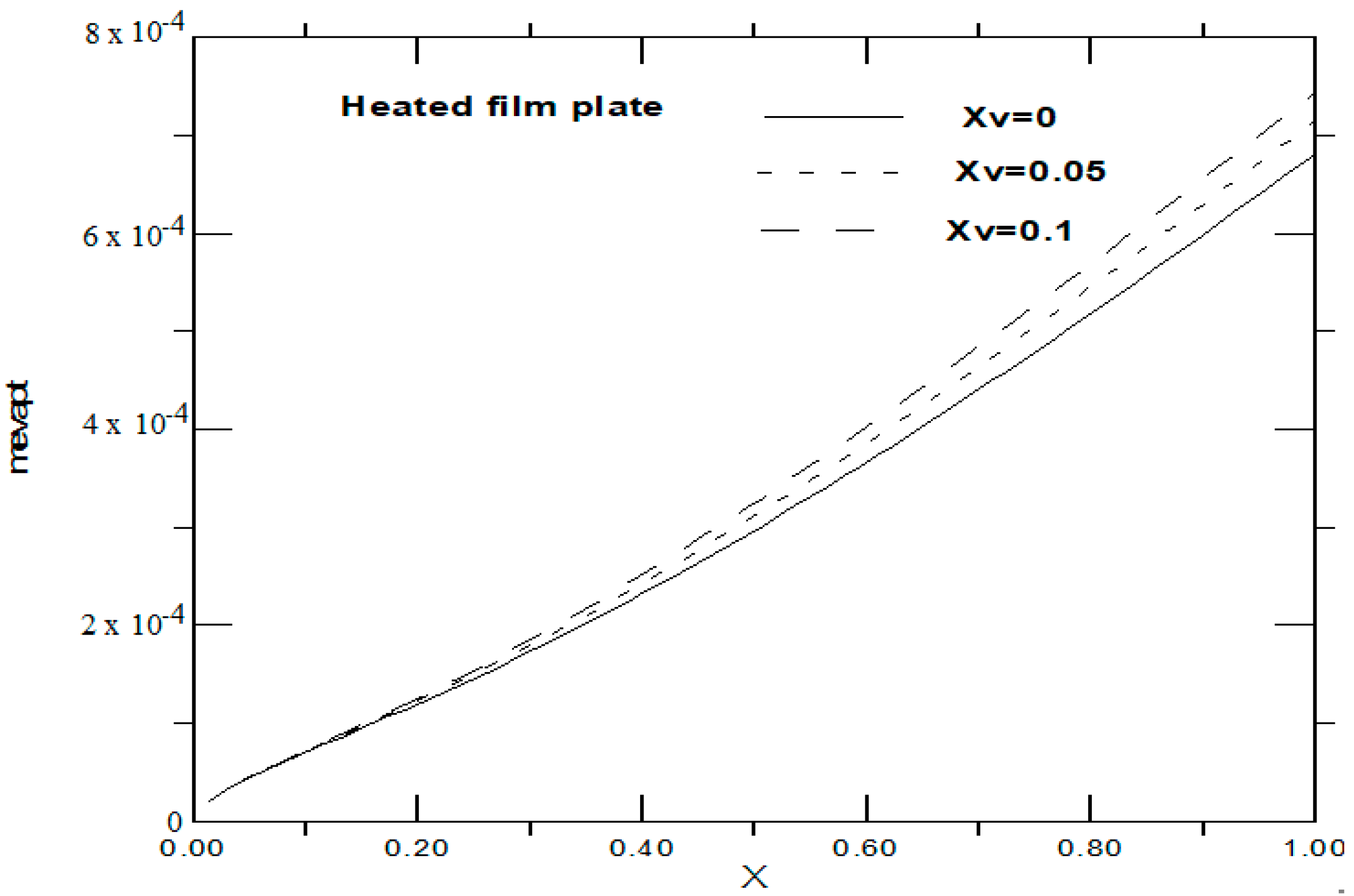
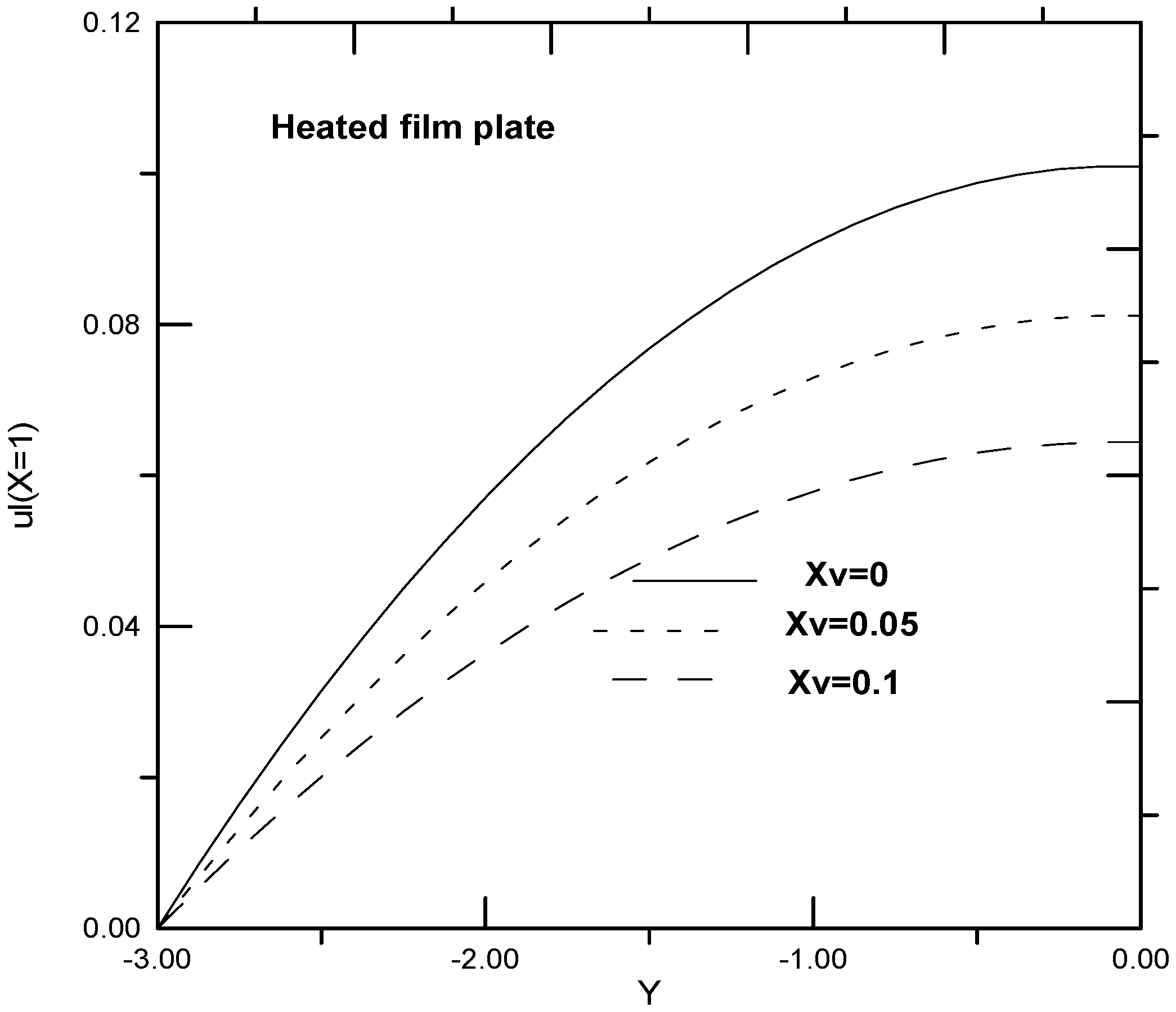
| POSITION AXIALE | (121,121,81) | (121,121,21) | (121,51,41) | (121,51,21) | (71,51,21) | (51,41,21) |
|---|---|---|---|---|---|---|
| X = 0.2 | 333.73 | 333.65 | 333.45 | 333.42 | 333.60 | 333.39 |
| X = 0.4 | 334.96 | 334.92 | 334.81 | 334.73 | 334.91 | 334.69 |
| X = 0.6 | 337.43 | 337.39 | 337.29 | 337.22 | 337.12 | 337.36 |
| X = 0.8 | 339.06 | 339.02 | 338.88 | 338.77 | 338.71 | 338.98 |
| X = 1.0 | 340.35 | 340.31 | 340.18 | 340.11 | 340.02 | 340.28 |
© 2020 by the authors. Licensee MDPI, Basel, Switzerland. This article is an open access article distributed under the terms and conditions of the Creative Commons Attribution (CC BY) license (http://creativecommons.org/licenses/by/4.0/).
Share and Cite
Mohamed, A.B.; Hdidi, W.; Tlili, I. Evaporation of Water/Alumina Nanofluid Film by Mixed Convection Inside Heated Vertical Channel. Appl. Sci. 2020, 10, 2380. https://doi.org/10.3390/app10072380
Mohamed AB, Hdidi W, Tlili I. Evaporation of Water/Alumina Nanofluid Film by Mixed Convection Inside Heated Vertical Channel. Applied Sciences. 2020; 10(7):2380. https://doi.org/10.3390/app10072380
Chicago/Turabian StyleMohamed, A. Belhadj, Walid Hdidi, and Iskander Tlili. 2020. "Evaporation of Water/Alumina Nanofluid Film by Mixed Convection Inside Heated Vertical Channel" Applied Sciences 10, no. 7: 2380. https://doi.org/10.3390/app10072380
APA StyleMohamed, A. B., Hdidi, W., & Tlili, I. (2020). Evaporation of Water/Alumina Nanofluid Film by Mixed Convection Inside Heated Vertical Channel. Applied Sciences, 10(7), 2380. https://doi.org/10.3390/app10072380






